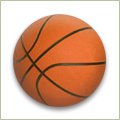 Beth Biscoff
Beth BiscoffOne of the reasons I write this blog is to support the idea that there should be a specialty devoted to the science and practice of optimizing health, preventing injury, and enhancing the performance of basketball players.
There's already the STMS (The Society for Tennis Medicine and Science). There should be an SBMS (Society for Basketball Medicine and Science) as well, don't you think? I do, but we're getting off the subject here...........
Usually, when I want to see what other folks are up to, I perform a google search for "basketball medicine" . What comes up? Well, this blog, for one, but otherwise, mostly ads for medicine balls that can be used in training for basketball (and an ocassional reference to the Medicine Hat College Women's Basketball Team - Go Rattlers).
It's time to recognize the use of Medicine Ball Drills for basketball training.
And, personal allegiances aside, I can think of no better person to offer a list of medicine ball drills for basketball than Jonas Sahratian, the Strength and Conditioning Coordinator of the UNC Men's Basketball team.
Here's a link to the article that appeared last year in Men's Health.
Remember, though, this workout is really for older (ages 16+ for girls and 18+ for boys) players who are more physically mature. If you're in that older age group and want to increase your core strength, and power - this would be a good addition to your current workouts. Start slow, increase your load, and measure your results (how you feel, how you move, how you improve your performance on the court).













